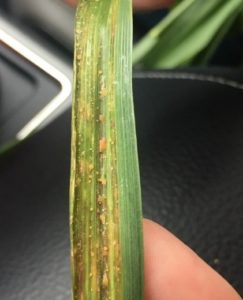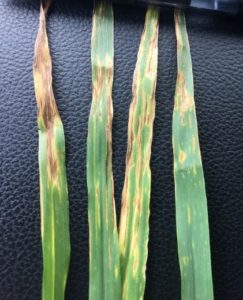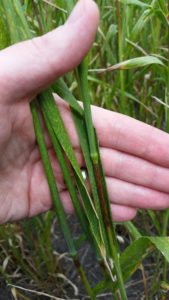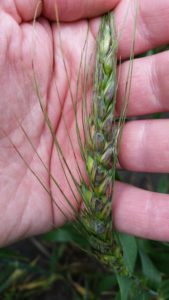The bacterium that causes bacterial streak and black chaff disease in wheat and other small grains is Xanthomonas translucens. In Texas, other species of Xanthomas cause leaf diseases of cotton, tomato and pepper. In the food industry, Xanthomonas species are grown to produce a carbohydrate, xanthan gum, which is used to thicken foods such as ice cream. Xanthomonas translucens has four known pathovars. A pathovar is a sub-species designation that refers to strains of the bacterium that differ in their host range. Three pathovars infect wheat and various other cereals, while one pathovar only infects barley. While these pathovars are genetically different, the symptoms that they cause in wheat and other cereals are similar.
Prior to heading, bacterial streak is the first phase of the disease that appears on the plant due to this pathogen. It most often occurs under irrigation or high rainfall regions of Texas. Once established on the infected plant, the bacteria subsequently spread, eventually reaching the head. Later in the season, under favorable conditions, the later phase of the disease called “black chaff” becomes visible on affected stems and heads. Pathogen infection is promoted by moisture, such as rain or overhead irrigation. Development of disease is more rapid under warm conditions. The bacteria can infect plants through physical wounds, but also through natural openings like the stomata. The bacterial pathogen is primarily seedborne. Survival and transmission from infected crop residues and alternate hosts are not significant under Texas conditions.
Figure 1. Bacterial streak symptoms in barley, showing lesions (dead tissue), as well as water-soaking and bacterial exudate (white flakes). Photo courtesy of Tom Isakeit.
The bacteria can survive on the plants without infecting them and are spread primarily through splashing water, but also insect movement from one plant to another, or plant-to-plant contact from wind. In addition to wheat, other hosts are barley, oats, rye, triticale and other grasses. Bacterial streak on the flag leaf can result in yield loss through reduced seed weight and kernel number. With 50% of the flag leaf affected, yield loss can be 8-13% yield loss, and if 100% of the flag leaf is affected, yield loss can range from 13-34%. Another study indicated losses of up to 40% were possible in severe cases. In these cases however, yield loss was attributed to flag leaf damage and impacts on yield from the black chaff symptoms alone are not well documented.
SYMPTOMS
Bacterial Streak
Symptoms of the bacterial streak phase of the disease on leaves appear between veins, initially as elongated water-soaked, light-brown lesions that progressively becomes necrotic as weather conditions become dry (Figure 1). Under favorable conditions, the lesions enlarge and may coalesce to affect large leaf areas (Figure 2). Under humid conditions, bacteria ooze in the form of a thick liquid from symptomatic areas which subsequently dries to form tiny granules, and sometimes flakes, with a yellowish tint on leaf surfaces (Figure 2). These diagnostic symptoms are most pronounced in the morning or after rain. The presence of water-soaking and bacterial ooze, especially under wet conditions, can help to distinguish this disease from other similar looking fungal diseases like Septoria leaf blotch and Stagonospora leaf blotch. These diseases only appear occasionally in Texas and generally produce necrotic lesions that often are surrounded by a yellow halo. Septoria and Stagonospora leaf blotch also have several dark and lighter gray brown fruiting bodies or specks respectively in the necrotic areas. Incidences of bacteria streak symptoms usually progresses from the lower to the upper leaves, but the disease has been known to skip the streak phase and only appear as “black chaff” after heading.
Figure 2. Bacterial exudates produced on wheat leaves from Xanthomonas translucens (left). After water-soaked regions appear on the leaves from the infection, these areas of the leaf then turn brown and necrotic (middle). Dried bacterial exudate seen as flakes on plant surface (right). Photos courtesy of Justin Choplas and Ken Obasa.
Black Chaff
Symptoms of the black chaff phase of the disease on affected heads appear as dark longitudinal stripes on glumes. Additionally, black purplish lesions are visible on glumes, peduncle (stem) and rachis (Figure 3). On awned wheat varieties, a “barber pole” pattern appears on the awns with alternating regions of green and black along the length of each awn (Figure 3). Some wheat varieties also exhibit genetic melanosis (darkened glume tissue) which does not impact yield. It also can sometimes be confused with black chaff, but does not result in the barber pole pattern on awns. In severe cases where yield is impacted, seeds are aborted or shriveled.
Figure 3. Typical black-purple colored glumes (left) and stem (middle) resulting from Black Chaff in wheat. “Barber pole” pattern on awns of affected head (right). Photos courtesy of Clark Neely.
CONTROL
During the season, the disease cannot be controlled. There are no effective chemicals that can be sprayed on the plants to treat or prevent infection. Likewise, there are no seed treatments that can eliminate the pathogen from infected seeds. The severity of the disease is affected by the susceptibility of the variety, the degree of seed infestation with the bacteria, and weather conditions – specifically rain, which promote spread of the pathogen. Damage to the flag leaf will be the driving factor for yield loss.
Prevention is currently the best management strategy for this disease. Buying certified, pathogen-free seed should be the number one priority in a good management plan to limit infection of wheat plants. Crop rotation and tillage can also help in reducing inoculum sources, especially in fields with infected residue; however Xanthomonas does not survive long outside of the seed or living host. In one study, the wheat pathogen was not detectable in crop debris, soil and other plant species (weeds) three months after harvest of the crop. While differences in resistance do exist among wheat cultivars to this disease, they are not well documented and none are thought to have strong resistance. Resistance is quantitative, meaning that the variety can be infected, but symptoms are slow to develop and there is reduced severity.
Seed increases for certification or otherwise should be at least ¼ mile away from potential sources of inoculum, including actively growing wheat fields or fields with wheat stubble still present. Controlling grassy weeds and volunteer cereals that serve as alternate hosts can also help to reduce inoculum loads.
ADDITIONAL CONSIDERATIONS FOR PRODUCERS
Generally, seeds from a previously infected stand should not be used for planting, even when the seeds are from areas of the field not showing symptoms. The goal here is prevention of a possible, future outbreak by eliminating the primary source of the pathogen – contaminated seed. In some years, perhaps many years, because of weather conditions, planting infested seed will not lead to disease development. But the risk is there.
Producers can send seed samples for diagnosis for the causative pathogen to diagnostic laboratories in Texas like the Texas High Plains Plant Disease Diagnostic Laboratory in Amarillo. Prevention is however the best option, and as such, producers should consider purchasing Black chaff-free certified seeds from commercial seed companies.
Texas High Plains Plant Diagnostic Laboratory
Texas A&M AgriLife Research and Extension Center at Amarillo
6500 Amarillo Blvd W., Amarillo, TX 79106
(806) 677-5600
https://amarillo.tamu.edu/amarillo-center-programs/extension-plant-pathology/texas-plant-diagnostic-clinic-thppdl/
Dr. Clark Neely, State Small Grains Extension Specialist, College Station, TX 979-862-1412
Dr. Ken Obasa, Extension Plant Pathologist, Amarillo, TX 806-677-5600
Dr. Tom Isakeit, Extension Plant Pathologist, College Station, TX, 979-862-1340
Produced by the Department of Soil and Crop Sciences and
Department of Plant Pathology and Microbiology
https://soilcrop.tamu.edu
https://plantpathology.tamu.edu
The information given herein is for educational purposes only. Reference to commercial products or trade names is made with the understanding that no discrimination is intended and no endorsement by the Texas A&M AgriLife Extension Service is implied.
TEXAS A&M AgriLife Extension Service
AgriLifeExtension.tamu.edu
Texas A&M AgriLife Extension is an equal opportunity employer and program provider.
The Texas A&M University System, U.S. Department of Agriculture, and the County Commissioners Courts of Texas Cooperating







